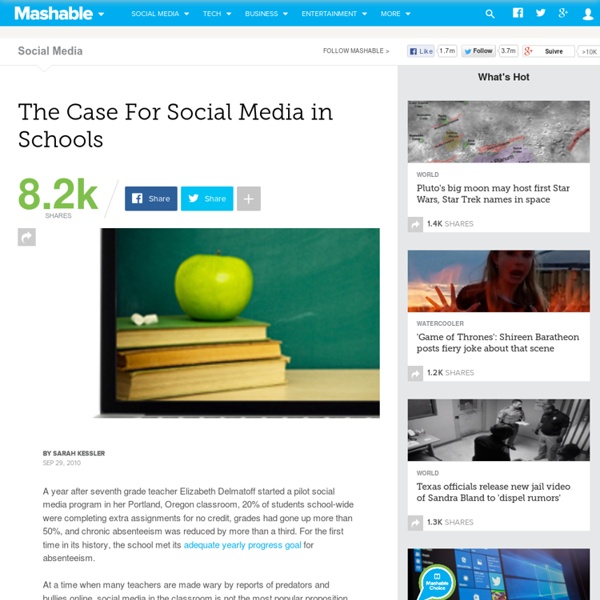7 Fantastic Free Social Media Tools for Teachers
The possibilities for social media tools in the classroom are vast. In the hands of the right teacher, they can be used to engage students in creative ways, encourage collaboration and inspire discussion among even soft-spoken students. But we've already made our case for why teachers should consider using social media in their classrooms. What about the how?
Twitter, Facebook, and social activism
At four-thirty in the afternoon on Monday, February 1, 1960, four college students sat down at the lunch counter at the Woolworth’s in downtown Greensboro, North Carolina. They were freshmen at North Carolina A. & T., a black college a mile or so away. “I’d like a cup of coffee, please,” one of the four, Ezell Blair, said to the waitress. “We don’t serve Negroes here,” she replied. The Woolworth’s lunch counter was a long L-shaped bar that could seat sixty-six people, with a standup snack bar at one end.
Google+, Facebook, Twitter, and Blogs - When and Why to Use Each
After week one I shared my thoughts about “What Google+ Means for Education.” I’m on week two now and the big questions are: Do I really need to join another social network? Answer: Yes.If I join Google+ can I give up Facebook, Twitter, and blogs?
Using social media in education, Part 1: Opportunity, risk, and policy
Introduction Universities and colleges increasingly are using new communication technologies to produce innovative teaching methods, thus improving relationships with staff and students. Much of this innovation is centered on social media spaces and concepts.
The Best TED Talks To Make Use Of Social Media
TED has been regaling us for years now with inspirational speeches about just about every important topic there is to talk about. And throughout that time, more than a few TED speakers have chosen to talk about the internet, social media and how this will shape our future. So, here we are, everyday citizens of the world with an itch to do something amazing with the internet we’ve created. Let’s see what TED can inspire us to do to with it.
Social Media Networking
Posted on 20 July 2009 by asmodeus Welcome! If you like what you read, please subscribe to my RSS feed.
Using social media in education, Part 2: Tools, support, and technical issues
Social media tools in education Social media tools are changing the education landscape. These tools tend to fall into two broad categories: those primarily intended for social networking, such as Facebook or Twitter, and those that are designed for sharing user-generated content such as blogs, YouTube, or Flickr.
5 Social Media Lessons Learned from Whole Foods
As a company, Whole Foods has impressively embraced social media more than most, gathering over 1.2 million followers on Twitter and 123,000 fans on Facebook in the process. While it is easy to understand why a relatively young company or one started by a tech-savvy founder would so completely embrace social media communication tools, it is quite a bit more remarkable for an almost 30 year old established brick and mortar company with roughly 50,000 employees and over 270 stores worldwide to have done so. I recently visited the Whole Foods headquarters in Austin, Texas to meet with members of their new media team, including Bill Tolany, the company’s Senior Coordinator of Integrated Media, and Winnie Hsia, who oversees the @wholefoods account. I wanted to know how Whole Foods integrated social media tools into their communications strategy, and what lessons had they learned from doing so. Below are five of the lessons that Whole Foods shared with me during our chat. 1.
Social Media
Social media includes varied online technology tools that allow people to communicate easily via the Internet to share information and resources. The dramatic growth of social media creates new opportunities for engaging students. These include social networking sites such as Facebook, MySpace, LinkedIn and Twitter along with blogs and wikis.
16 social media guidelines used by real companies
In a post I wrote called the A-Z of social media for brands I decided that P stands for Policy. I'm not one for too many rules and regulations, but it is a good idea to define some clear guidelines to help staff (especially novices) to do the right thing. So let’s take a look at some real world social media policies and guidelines as used by companies. Zappos does a great job of summing it up in seven words, but the detail is also important and there are some fine suggestions here... Don't pick fights, be the first to correct your own mistakes, and don't alter previous posts without indicating that you have done so. Try to add value.
How technology has changed childhood – ten stats
Over the past eighteen months Internet security company AVG (disclosure – Rabbit client) has been carrying out research to see how technology has changed childhood, beyond recognition from someone who grew up twenty or thirty years ago. With five waves looking at kids from birth across eleven countries, the end result is a fairly extensive piece of research. Ten key stats are as follows: 1 – 81% of children under two currently have some kind of digital dossier or footprint, with images of them posted online. In the US that rises to 92%
5 Must-Read Social Media Marketing Studies
A lot is happening in the world of social media. Here’s a quick summary of recent major research findings: #1: By 2010, 26 Million (1 in 7) U.S. Adults Will Use Twitter Monthly
Social Media & Mobile Internet Use Among Teens and Young Adults
By Amanda Lenhart, Kristen Purcell, Aaron Smith and Kathryn Zickuhr Overview Since 2006, blogging has dropped among teens and young adults while simultaneously rising among older adults.



